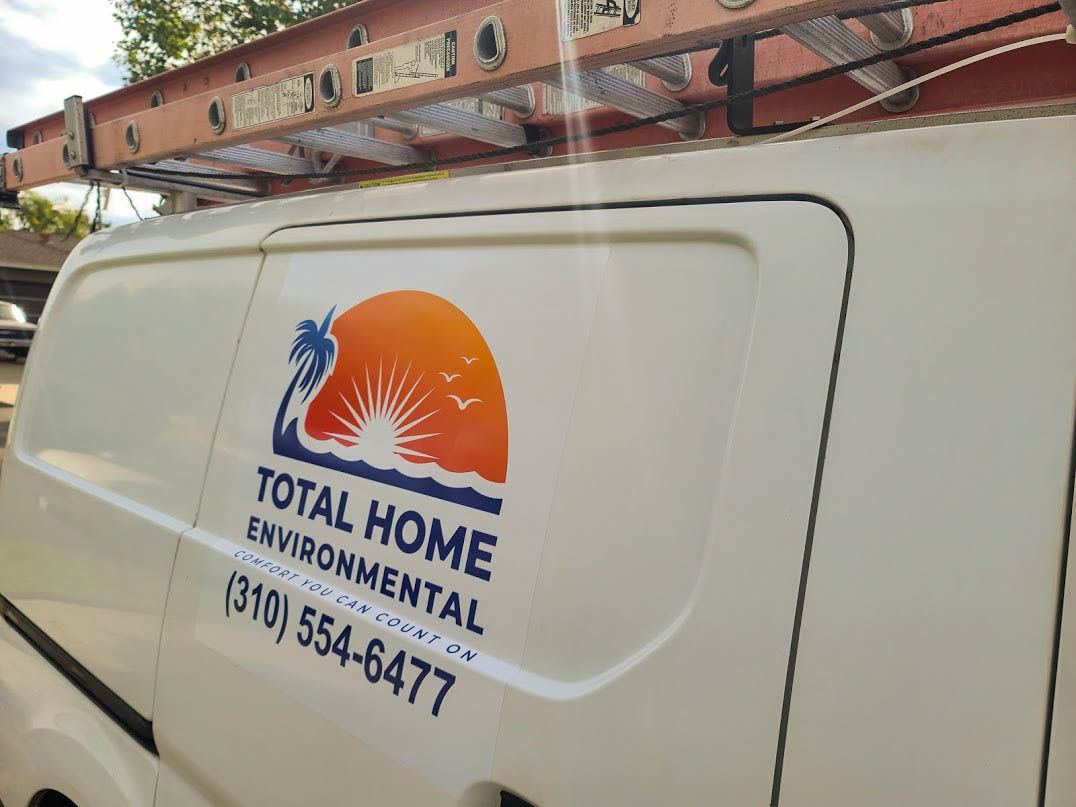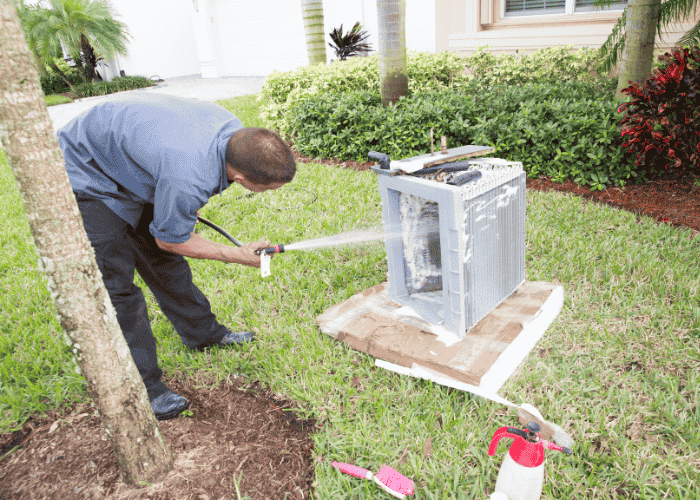September 18, 2025
AC outdoor coil cleaning is one of the most important maintenance tasks for South Bay homeowners, where unique coastal conditions make proper care crucial for system longevity. The outdoor coil, also known as the condenser coil, is responsible for releasing heat from your air conditioning system. In Torrance and surrounding coastal neighborhoods, salt air, marine debris, and seasonal pollen create the perfect storm for coil contamination. That makes air conditioner coil maintenance even more critical here than in inland areas.
When outdoor coils become dirty or corroded, the system must work much harder to keep your home cool. That leads to higher energy bills, reduced cooling capacity, and premature system failure. This guide will walk you through everything South Bay homeowners need to know: the unique local challenges, safety steps before cleaning, the difference between professional and DIY approaches, recommended maintenance schedules, and when to call Total Home Environmental for professional HVAC coil cleaning in Torrance.

South Bay Coastal Challenges for AC Coil Maintenance
Living in the South Bay comes with clear benefits: ocean breezes, moderate year-round temperatures, and scenic coastal views. But those same conditions create very specific maintenance challenges for your air conditioning system.
The biggest threat to AC outdoor coils in Torrance and nearby coastal towns is salt-laden air. Salt particles carried by ocean breezes settle on condenser coils and speed up corrosion of the thin aluminum fins. This corrosion reduces heat transfer efficiency, weakens structural integrity, and creates rough surfaces that trap even more dirt.
South Bay homes also face contamination from organic debris throughout the year. Spring brings heavy pollen that coats coils in sticky residue. Summer often introduces fine sand particles carried inland during Santa Ana winds. Fall and winter add leaf litter and decomposing matter that create acidic conditions, accelerating metal degradation.
For homeowners within five miles of the shoreline, these factors combine to produce contamination rates two to three times higher than in inland areas. That makes AC maintenance in the South Bay essential for reliability and efficiency.
Safety First: Electrical Precautions for Coil Cleaning
AC outdoor coil cleaning involves working near high-voltage electrical components, so safety procedures cannot be ignored. The outdoor condensing unit typically runs on 240 volts, which is powerful enough to cause serious injury or death if handled carelessly.
Essential Pre-Cleaning Safety Steps
Interior Thermostat Shutdown: Switch your thermostat to the "OFF" position, not just to a higher temperature. This prevents the unit from starting while you are working.
-
Electrical Disconnect: Locate the disconnect box near the outdoor unit, usually within three feet. It may be a breaker-style switch, a pull-out fused disconnect, or a knife switch.
-
Power Verification: After shutting off power, wait at least five minutes for capacitors to discharge. Make sure the system is completely off by confirming no lights are on and no humming or vibration is present.
Safety Reminders
-
Never spray water directly at electrical components.
-
Avoid metal tools near wires and connections.
-
Work during daylight hours for visibility.
-
If electrical procedures feel unfamiliar, call a professional instead of attempting DIY.
Professional HVAC coil cleaning in Torrance eliminates safety risks and ensures thorough, damage-free results.
Professional AC Outdoor Coil Cleaning Methods
Professional air conditioner coil maintenance involves choosing the right cleaning method for the type and severity of buildup. Total Home Environmental technicians inspect every system before deciding between water rinsing, chemical cleaning, or fin restoration.
Low-Pressure Water Cleaning
For light contamination, a low-pressure water rinse is often sufficient. The key is spraying from inside the coil outward, opposite to normal airflow, so debris is pushed out instead of deeper into the fins. Only standard garden hose pressure should be used. Power washers can bend the delicate aluminum fins permanently.
Water rinsing works best for quarterly cleanings, removing loose dirt, grass clippings, or pollen that accumulates in lighter layers.
Professional Chemical Cleaning
When water is not enough, non-acidic alkaline foam cleaners designed for aluminum coils are applied. These cleaners foam up, expand into tight spaces, and break down salt, grease, and sticky organic matter.
The process involves:
-
Protecting nearby plants and landscaping.
-
Applying the cleaner evenly across the coil.
-
Allowing 10 to 15 minutes for dwell time.
-
Performing a thorough low-pressure rinse.
This method is essential for coils suffering from salt buildup, biological growth, or thick layers of pollen.
Fin Straightening and Restoration
Bent fins restrict airflow and reduce efficiency. During professional cleaning, fins are inspected and carefully straightened with a fin comb. In highly corrosive environments, protective coatings may also be recommended to slow down future damage.
DIY Coil Maintenance: Safe Steps for Homeowners

Not all maintenance requires a professional visit. Homeowners can take simple steps to extend the time between cleanings and keep their systems operating more efficiently.
Vegetation Management
-
Maintain at least three feet of clearance around the unit.
-
Trim back shrubs, hedges, or branches.
-
Remove weeds or vines that restrict airflow.
-
Redirect sprinklers so water does not spray directly onto coils.
Safe Rinse Procedures
For those comfortable with electrical safety, a gentle rinse can be done:
-
Shut off the system at the thermostat and disconnect power at the box.
-
Wait several minutes for capacitors to discharge.
-
Use only garden hose pressure.
-
Spray from inside the unit outward.
-
Focus on visibly dirty areas rather than soaking the entire surface.
-
Let the coil dry fully before restoring power.
DIY Limitations
Some tasks should never be attempted by homeowners:
-
Using chemical cleaners
-
Straightening fins without the right tools
-
Disassembling components
-
Pressure washing
-
Working with the power connected
These activities risk damaging the coil or creating electrical hazards.
How Often Should You Clean AC Outdoor Coils?
The recommended frequency for AC outdoor coil cleaning depends heavily on your distance from the coastline.
-
Within 1-3 miles of the coast: Professional cleaning every 3-4 months, with monthly homeowner inspections. Salt spray exposure demands aggressive upkeep.
-
3-10 miles inland: Professional cleaning every 6 months, ideally in spring and fall, with bi-monthly homeowner maintenance.
-
More than 10 miles inland: Professional cleaning once per year, preferably in spring, with quarterly homeowner inspections.
Seasonal Maintenance Calendar
-
Spring: Professional cleaning to remove winter debris and prepare for heavy summer use. Also, check refrigerant and electrical connections.
-
Mid-Summer: Inspect visually for buildup. Rinse lightly if dirt is visible and ensure vegetation is trimmed back.
-
Fall: Remove accumulated debris. For high-exposure homes, schedule a second professional cleaning. Prepare for reduced winter operation.
Even a thin layer of buildup reduces efficiency. Studies show coils clogged by just one-tenth of an inch can increase energy consumption by 20 percent.
Condenser vs. Evaporator Coils: Knowing the Difference
Many homeowners confuse outdoor condenser coils with indoor evaporator coils. Both are vital, but they require very different cleaning methods.
-
Condenser Coils (Outside): Release heat from your home into the air. Accessible for homeowner rinsing and requires frequent cleaning in coastal environments.
-
Evaporator Coils (Inside): Absorb heat from your indoor air. Located inside the air handler or furnace, they are tightly integrated with refrigerant lines and electrical systems.
Evaporator coil cleaning should always be performed by professionals. Attempting to clean them yourself risks refrigerant leaks, electrical damage, and voided warranties. Focus your DIY efforts exclusively on outdoor condenser coils and leave indoor evaporator coils to qualified technicians.
Professional Benefits: Why Call Total Home Environmental
While routine homeowner upkeep helps, professional HVAC coil cleaning in Torrance delivers benefits that DIY methods cannot.
Professional service includes:
-
Complete inspection of coil condition and contamination type
-
Refrigerant pressure testing
-
Electrical connection checks
-
Cleaning with the right non-acidic chemicals
-
Fin straightening and restoration
-
Application of protective coatings where needed
-
Indoor air quality evaluations and ductwork checks
When to Call a Professional
-
Rising energy bills despite steady usage
-
Reduced cooling or longer system run times
-
Visible corrosion that does not rinse off
-
Bent or damaged fins
-
Strange noises or ice forming on coils
-
Annual tune-ups or warranty-required maintenance
The cost of professional cleaning is quickly offset by improved efficiency. Clean coils can reduce energy consumption by 15 to 30 percent. Proper maintenance can also extend system lifespan by three to five years. In the South Bay's corrosive coastal environment, that difference often means replacing a system at year 12 instead of year 8.
Protecting Your Investment in the South Bay
AC outdoor coil cleaning is one of the most important maintenance tasks for South Bay homeowners. Salt air, pollen, and debris attack coils year-round, which means maintenance must be consistent. Following electrical safety steps is essential. Frequency depends on coastal proximity. Homeowners can manage vegetation and light rinsing, but professional cleaning provides complete care with specialized tools and knowledge.
Key takeaways for South Bay homeowners:
-
Salt air and pollen buildup are constant threats.
-
Safety procedures must be followed before any cleaning.
-
The frequency of cleaning depends on how close you are to the ocean.
-
DIY rinses help, but do not replace professional maintenance.
-
Professional service extends system life, improves efficiency, and prevents costly repairs.
For Torrance and South Bay residents, Total Home Environmental is the trusted choice for professional AC maintenance in the South Bay. Our technicians understand the demands of coastal climates and use proven techniques to keep systems reliable and efficient.
Do not wait until your AC struggles to keep up on the hottest day of summer. Call Total Home Environmental today to schedule expert HVAC coil cleaning in Torrance and protect your investment in comfort, efficiency, and peace of mind.


